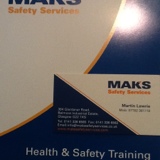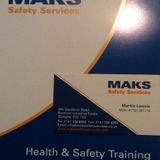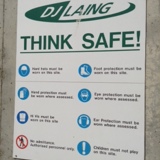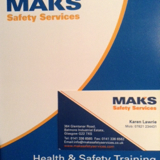Information
-
Audit Title
-
Client / Site
-
Conducted on
-
Prepared by
-
Location
-
Personnel
INFRASTUCTURE
-
Can all doors be opened inwards and outward to allow safe exit in an emergency?
-
Is there adequate workspace in the workshop for the projects taking place?<br>
-
Are floors free of slip and trip hazards?<br>Including oil<br>power leads, ropes, cables<br>tools<br>rubbish, waste, debris, swarf
-
Does the workshop floor drain properly?
-
Are the work benches and trolleys at a suitable height for working and lifting items?
-
Workbenches are clear free from fire and COSHH hazards.
-
Are work benches at a height suitable for the tallest and shortest staff?
-
Is there good ventilation in the area?<br>Welding area<br>painting/solvent areas<br>chemical storage
-
Is the lev tested
-
Is the lighting sufficient for the tasks being undertaken?
-
Are lighting fixtures covered in the event that a glass is broken?
-
Are jacks, cranes and hoists present and rated to suit the lifting needs of the projects?
-
Are hoists routinely serviced and chains checked for wear?<br>Do records exist to support servicing requirements?
-
Is the minimum load bearing capacity clearly marked on jacks, cranes, gantries and hoists?
-
Is shelving strong enough to hold loads?<br>Do racking shelves display safe working load limits?
-
Is there a safety cage for the inflation of split rimmed tyres?
-
Is there a safety cage available to raise workers if needed to service equipment.?<br>Is the safe working load displayed?<br>Is a harness available for use in the cage?<br>Do records of harness inspections exist? Is it current?<br>Have any modifications been certified by an engineer?
-
Are stands used to support raised vehicles, machinery and equipment?
-
-
Are there safety signs in place at<br>welding bays<br>chemical storage<br>PPE maintenance and storage<br>electrical and mechanical hazards
-
Are there separate rubbish bins for combustible and non combustible waste?
-
Are gutters and areas around the building free of debris and rubbish?
-
Are ladders and other means of working at heights stored away and inaccessible to unauthorized persons?<br>Are these items inspected regularly to be in good repair?<br>Do records exist to support this?
-
Do ladders and stairs comply with Standards?
-
Is a falls arrest harness available for use when working at heights?<br>Do records exist to demonstrate regular inspection of the condition of the harness?
-
Are buildings and structures fitted with handrails, mezzanine, scaffolding or other means to prevent falls?
-
-
Is there a pit with appropriate barriers or guards in place?
ELECTRICAL TOOLS AND POWER SUPPLY
-
Is all electrical work conducted by a qualified and licenced electrician?
-
Are overhead power lines clearly marked and visible/ clear of machinery?
-
Are signs in place to locate and identify cables, pipes and other utilities?
-
Is all electrical wiring in a conduit if it is at risk of being cut, or struck by a person?
-
Are all power tools double insulated?
-
Are only heavy duty extension power leads in use?
-
Are all electrical tools and leads regularly inspected, tested and tagged?<br>Is a register available and up to date?
-
Is an RCD fitted to the electrical circuit board?<br>Is it routinely tested?<br>Do records exist to support routine inspection and testing?
-
Are portable electrical tools unplugged and put away when not in use?
-
Are all electrical switches and power points undamaged?
-
Is the electric power board protected from the weather and water?
-
Are outside power points weatherproof?
-
Is there any risk of contact between electrical equipment and leads with water?
WORKSHOP EQUIPMENT
-
Are welder electrodes and connections in good condition?
-
Is ventilation adequate when welding?
-
Are protective screens available and used to protect bystanders when welding?
-
Are flash guard helmets used and in good condition?
-
Are oxyacetylene cylinders used and stored securely and in an upright position?
-
Are flash arresters fitted to all oxyacetylene equipment?
-
Are pressure gauges on oxyacetylene cylinders in working order and well maintained?
-
Are all oxyacetylene hoses and fittings in good condition and free of leaks?
-
Are bench grinders securely positioned away from traffic areas?
-
Are bench grinder wheels regularly dressed and tool rests correctly adjusted?
-
Are bench grinder wheels guarded and eye shields in place?
-
Are all other power tool guards in place and well maintained?
-
Is the air compressor properly guarded?
-
Are all pressure vessels registered, regularly inspected for damage and within cylinder expiry date?
-
Is the air compressor located away from work areas to reduced noise?
-
Are batteries regularly charged in a well ventilated area away from heat, sparks and flames?
-
Are pressure gauges available to correctly inflate tyres?
-
Is personal protective equipment PPE for all work, including eye goggles, welding helmet and hearing protection available and worn by staff?
-
Is combustible materials stored away from sparks?
-
Are exhaust systems on equipment in good order to reduce fumes, emissions and risk of fire?
EMERGENCY PREPAREDNESS
-
Does the workshop have an evacuation plan displayed next to exits?
-
Has an evacuation assembly area been identified and sign posted?
-
Are fire extinguishes in place and of the correct type for use in a workshop?
-
Are fire extinguishers easily accessible, unobstructed and sign posted?
-
Are fire extinguishers up to date with annual inspections?
-
Is a first aid kit accessible?
-
Is the first aid kit regularly services to ensure sufficient supplies exist in an emergency?
-
Is a list of currently qualified first aid attendants available near the kit?
-
In an emergency can emergency services be contacted?
-
Are there trained emergency wardens available to cover all working areas and all working hours?
-
Are emergency drills conducted at least every 6months?
-
Other comments.
Storage and use of COSHH, OIL, Etc.
-
Is any hazardous material left out unsealed, in trays or unauthorised containers?
-
Are drums stored stacked and in bunded areas, other than minimum quantities in use?
Traffic management
-
Is there safe movement for vehicles entering and leaving the workshop?
-
Are pedestrians kept separated from vehicle movement ?
OTHER HAZARDS
-
Is a NO SMOKING policy in place, and applied consistently?
-
Are adequate amenities available and in working order?<br>Are they regularly cleaned?<br>Do they provide an area that maintains personal dignity in an emergency?<br>Are they sufficient to meet the needs of the maximum number of people on site?
-
Do you have a regular system of pest and vermin control?<br>Is a licensed professional engaged for these activities?<br>Is the monitoring and treatment program documented?
-
Supervisor in charge of workshop
-
Safety Advisor, John Lawrie.












